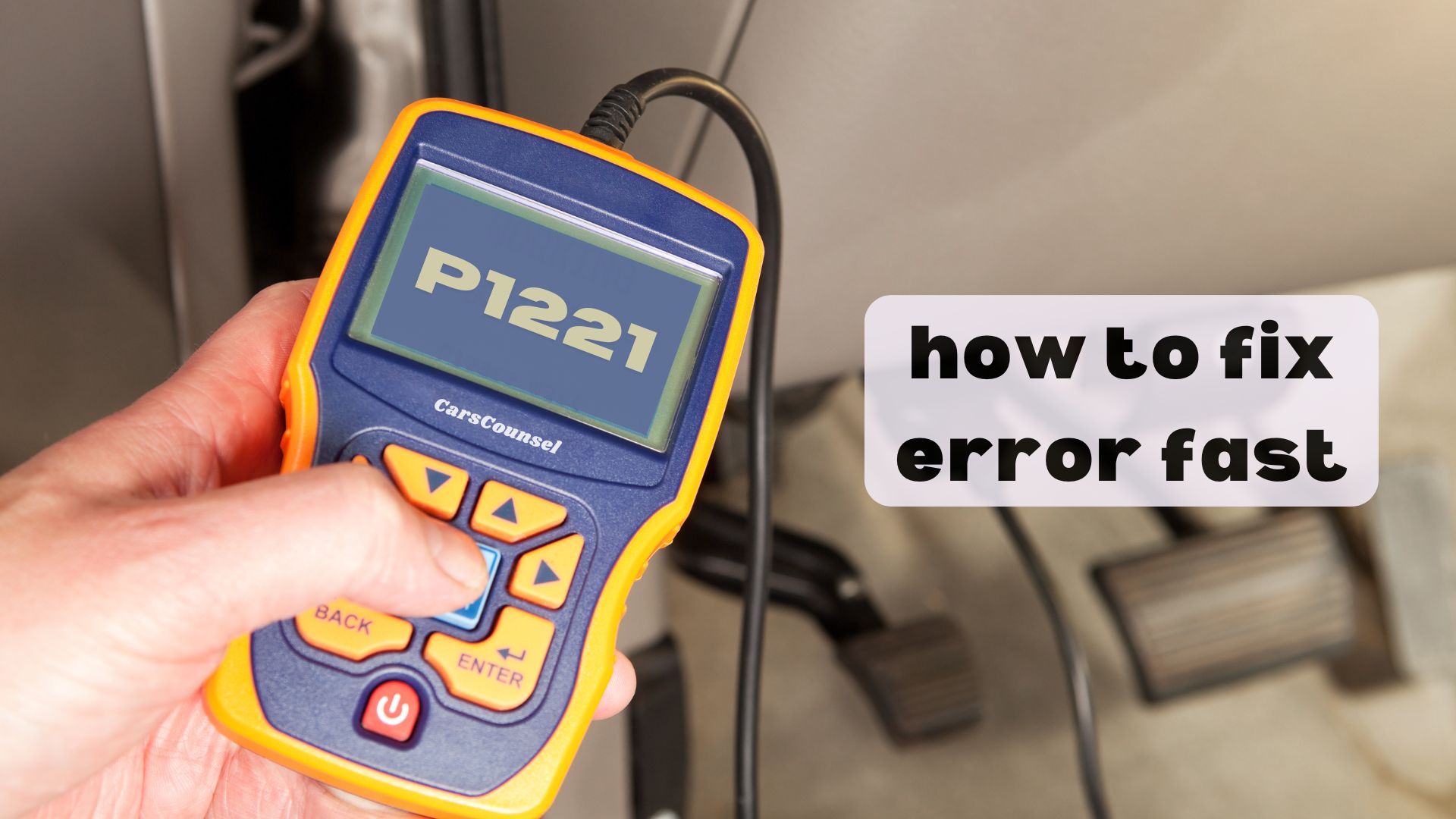You might be surprised to learn that a staggering 20% of engine performance issues can be traced back to faulty throttle position sensors. One common culprit is the P1221 code, which indicates a discrepancy between the signals from two throttle position sensors. This fault code can lead to frustrating symptoms like engine stalling, hesitation, and poor performance.
But what’s causing this correlation issue, and how do you fix it? Is it a simple sensor replacement, or is there more to it? You’re about to find out the answers to these questions and get back on the road to peak engine performance.

Quick Navigation
Key Takeaways
- The P1221 code is triggered when the onboard computer detects a discrepancy between the signals from two throttle position sensors.
- Correlation issues between Throttle Position Sensor 1 and 2 can cause fuel and air mixture problems, affecting engine performance.
- Faulty throttle position sensors, corrosion, or incorrect installation can cause the P1221 code and disrupt engine performance.
- The throttle position sensor monitors throttle valve position and sends information to the engine control module, which adjusts fuel and air mixture accordingly.
- Replacing the faulty throttle position sensor, cleaning corroded connectors, and re-calibrating the sensor can resolve the P1221 code and restore proper engine function.
Code P1221 Description Explained
When your vehicle’s onboard computer detects a discrepancy between the signals from two throttle position sensors, it triggers the P1221 diagnostic trouble code.
This code indicates a throttle position sensor (TPS) 1-2 correlation issue, affecting fuel and air mixture for peak engine performance.
The throttle position sensor monitors throttle valve position and sends information to the engine control module (ECM), which adjusts fuel and air mixture based on this data.
Sensor accuracy is pivotal, as incorrect fuel delivery leads to poor vehicle performance and efficiency.
Throttle calibration plays a fundamental role in ensuring the correct air-fuel mixture, and any discrepancy can trigger the P1221 code.
Understanding the code’s description is essential to diagnose and fix the issue efficiently.
Common Causes of P1221 Code
Faulty throttle position sensors are a leading cause of the P1221 code, as they can send incorrect signals to the engine control module (ECM), disrupting the delicate balance of fuel and air mixture.
When these sensors fail, they can cause the ECM to receive conflicting information, leading to poor engine performance and decreased fuel efficiency.
Wiring issues, such as corrosion or damage, can also prevent the sensors from sending accurate signals to the ECM.
Additionally, mechanical problems with the throttle system, ECM software malfunctions, and environmental factors can also contribute to the P1221 code.
You’ll need to identify and address the underlying cause to resolve the issue.
Symptoms of a Faulty TPS
You’ll likely notice several symptoms if your throttle position sensor (TPS) is faulty, including engine stalling or hesitation, especially when you’re accelerating from a standstill or driving uphill.
This sensor failure can cause throttle issues, leading to poor engine performance. You might experience rough idling or erratic engine behavior, making it difficult to maintain a steady speed.
Additionally, you may notice a decrease in fuel efficiency, which can be frustrating and costly. If you’re experiencing a lack of power or acceleration, it could be related to a faulty TPS.
Don’t forget to check your dashboard for the illumination of the check engine light, which can indicate a problem with your throttle position sensor.
Diagnosing the Throttle Position Sensor
To diagnose a throttle position sensor issue, start by connecting a scan tool to your vehicle’s onboard computer. This will allow you to access the onboard diagnostics (OBD) system and retrieve trouble codes.
Next, perform a sensor calibration to verify the throttle position sensor is providing accurate data to the engine control module (ECM). Check for any throttle adjustment issues that may be affecting the sensor’s performance.
Use the scan tool to monitor the throttle position sensor’s voltage output and compare it to the manufacturer’s specifications. If the output is inconsistent, it may indicate a faulty throttle position sensor.
Repairing the Throttle Position Sensor
Precision is key when repairing a throttle position sensor, as even slight deviations from the manufacturer’s specifications can lead to subpar engine performance and decreased fuel efficiency.
To begin, you’ll need to perform sensor maintenance by cleaning the throttle position sensor and its surrounding area. Gently remove any dirt, grime, or debris that may be affecting the sensor’s performance.
Next, inspect the sensor and its components for signs of wear or damage. If you find any issues, you may need to replace the sensor or its components.
Throttle cleaning is also vital, as a dirty throttle can cause the sensor to malfunction. By following these steps, you’ll be able to repair your throttle position sensor and get your engine running smoothly again.
Replacing Faulty Wiring or Connectors
Faulty wiring or connectors can cause the throttle position sensor to malfunction, leading to issues with the P1221 code.
As you diagnose and repair the issue, it’s essential to inspect and replace faulty wiring or connectors to guarantee proper communication between the throttle position sensor and the engine control module (ECM).
- Perform a thorough wire harness inspection to identify damaged or corroded wires.
- Use connector cleaning techniques to remove dirt and debris from connectors.
- Check for loose connections and tighten any that are found.
- Replace damaged or corroded wiring or connectors with new ones.
- Verify that all connections are secure and properly seated before reinstalling the throttle position sensor.
Clearing Trouble Codes and Relearn
Once you’ve replaced the faulty throttle position sensor and repaired or replaced damaged wiring or connectors, it’s essential to clear the trouble codes from the engine control module (ECM) and perform a throttle relearn procedure.
Use a scan tool to erase the trouble codes from the ECM’s memory. This step is critical to verify the ECM doesn’t continue to reference the faulty sensor data.
Next, follow the manufacturer’s relearn procedure to recalibrate the throttle position sensor. This process typically involves a series of throttle movements, such as slowly opening and closing the throttle, to teach the ECM the new sensor’s signal patterns.
Refer to your scan tool tips and the vehicle’s service manual for specific relearn procedures to guarantee accurate calibration.
Testing the Vehicle After Repair
After clearing the trouble codes and performing the throttle relearn procedure, you’re ready to test the vehicle to verify the P1221 code repair is successful.
This critical step confirms the issue is resolved and the vehicle operates as intended.
Follow a structured test drive protocol to validate the repair:
- Drive the vehicle under various conditions, such as city driving, highway cruising, and idling, to simulate real-world scenarios.
- Monitor the vehicle’s performance, paying attention to any signs of hesitation, stalling, or erratic behavior.
- Use a scan tool to monitor the throttle position sensor signals and verify they’re within the acceptable range.
- Check the fuel efficiency and compare it to the pre-repair condition.
- Verify the check engine light is no longer illuminated, indicating the P1221 code has been successfully cleared.
Estimated Repair Costs and Labor
Estimating the repair costs for a P1221 code diagnosis and fix can help you plan and budget for the necessary work. The cost to fix the issue can vary depending on the extent of the repair and the replacement parts needed.
| Repair Task | Repair Estimates | Labor Rates |
|---|---|---|
| Diagnosing the issue | $50-$100 | $75-$150 per hour |
| Replacing throttle position sensors | $100-$200 | $75-$150 per hour |
| Repairing wiring or connectors | $50-$100 | $75-$150 per hour |
| Performing throttle relearn procedure | $25-$50 | $75-$150 per hour |
| Total estimated cost | $225-$450 |
Keep in mind that these are rough estimates, and your actual cost may vary depending on your location and the auto repair shop you choose. It’s essential to consult with a professional technician to get an accurate estimate for your specific situation.
Additional Resources and Support
You’ve received a P1221 code diagnosis and are looking to fix the issue.
Now, it’s essential to have the right resources and support to guarantee a successful repair.
- Consult with TPS Experts for personalized guidance on diagnosing and fixing the throttle position sensor correlation issue.
- Search online forums dedicated to your vehicle’s make and model to gather information from owners who’ve experienced similar problems.
- Access factory service manuals for in-depth repair procedures and diagrams.
- Visit online repair communities to connect with experienced mechanics and DIY enthusiasts.
- Take advantage of online tutorials and videos that provide step-by-step repair instructions for the P1221 code.
More OBD-II Codes
Frequently Asked Questions
Can a Faulty Throttle Position Sensor Cause Long-Term Engine Damage?
You’re wondering if a faulty throttle position sensor can cause long-term engine damage. Yes, sensor failure can lead to incorrect fuel-air mixtures, causing engine wear and potentially resulting in premature wear on engine components, such as cylinder walls and piston rings.
Will a Throttle Relearn Procedure Reset My Vehicle’s Fuel Adaptation?
You’ll want to know that a throttle relearn procedure will reset your vehicle’s fuel adaptation, clearing fuel trims and adaptive memory, allowing the engine control module to relearn ideal fuel injection settings for improved performance and efficiency.
Are Throttle Position Sensors Specific to Certain Vehicle Makes and Models?
You need to guarantee sensor compatibility when replacing throttle position sensors, as they can be specific to certain vehicle makes and models due to varying electrical and mechanical configurations, requiring precise matching for peak performance.
Can I Drive Safely With a P1221 Code Until I Can Get It Fixed?
You can drive safely with caution, but it’s not recommended to delay repairs, as the P1221 code affects engine performance, potentially leading to stalling or loss of power. Limit your mileage and avoid strenuous driving until you can get it fixed.
Will a Tune-Up or Oil Change Affect the Throttle Position Sensor’s Performance?
You’re wondering if a tune-up or oil change will impact your throttle position sensor’s performance. The short answer is no, these routine maintenance tasks won’t affect sensor performance, as they’re unrelated to sensor maintenance, and won’t correct the underlying issue causing the P1221 code.
Conclusion
As you diagnose and repair the P1221 code, it’s astonishing how a small discrepancy in throttle position sensor signals can significantly impact engine performance. Coincidentally, a faulty sensor can be the culprit behind those frustrating instances of engine stalling and hesitation. By following the steps outlined above, you’ll be able to identify and fix the issue, restoring your vehicle’s peak performance and fuel efficiency.

